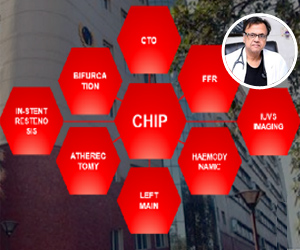- Home
- Editorial
- News
- Practice Guidelines
- Anesthesiology Guidelines
- Cancer Guidelines
- Cardiac Sciences Guidelines
- Critical Care Guidelines
- Dentistry Guidelines
- Dermatology Guidelines
- Diabetes and Endo Guidelines
- Diagnostics Guidelines
- ENT Guidelines
- Featured Practice Guidelines
- Gastroenterology Guidelines
- Geriatrics Guidelines
- Medicine Guidelines
- Nephrology Guidelines
- Neurosciences Guidelines
- Obs and Gynae Guidelines
- Ophthalmology Guidelines
- Orthopaedics Guidelines
- Paediatrics Guidelines
- Psychiatry Guidelines
- Pulmonology Guidelines
- Radiology Guidelines
- Surgery Guidelines
- Urology Guidelines
Chip angioplasty: A new kid in the cathlab

Traditionally CABG and percutaneous coronary intervention (PCI) have been the two methodologies for revascularization of advanced CAD for improvement of symptoms and prognosis.
Evidence-based medicine recommends that in severe disease with worsened systolic function, patients fare better with surgical revascularization. The safety and efficacy of left internal mammary artery (LIMA) bypass not only corrects the immediate obstructions but also stands as a warranty for future development of new lesions in the same artery. PCI while giving an immediate relief is confronted with more incidences of repeated revascularization giving a status of class II indications against the class I recommendation of CABG in severe disease.
It has been proposed that patients with CAD score less than 22 on SYNTAX Score can be safely undertaken by PCI and a patient with very aggressive SYNTAX score of more than 32 should not be subjected to PCI.
While there have been allegations of PCI overuse in lower risk patients. COURAGE trial, ORBITA trial, and many others have created an enormous negative public publicity that a large number of patients who are revascularized with stents could have been better managed with medical treatment. Yet, it is a matter of fact that a large number of patients with serious co-morbidities and heart failure are not investigated for the intent of most plausible treatment for them i.e. revascularization.
Darshan Doshi from Columbia investigated 60,000 patients of heart failure and reported that a very less percentage of patients were actually investigated by coronary angiography and lesser were treated by PCI, while these patients were potential candidates and had class I indications for revascularization by PCI or CABG.
It is a matter of record that the patients with higher CAD load (triple vessel, diffuse calcium thrombosis diseases) and those with comorbidities (cancer, COPD, etc) and with heart failure are less likely to undergo, even being offered revascularization by a percutaneous approach. Many of these patients are referred for surgery. Waldo et al in its landmark research identified that more than 25% of patients who are referred for CABG were actually turned down because of high risk for the surgery and many a time CABG can be done but does not offer complete revascularization. These turned down patients remain elusive to the treatments both by CABG or PCI and carry 6 times more mortality than those who were effectively revascularized.
Ironically, this is a population which is emerging out to be more and more as a distinct group needing revascularization. These are the patients who carry a high risk for a procedural intervention and in fact a higher reward as an outcome of the procedure. These are the patients who require a special skill set by an interventional cardiologist.
There is an urgent need of educating the medical community including the primary care physicians, cardiologists about the treatment options that are available now for these patients who were previously thought to be untreatable and for the same the urgent need of development of certain specialized centers which can be called chip (complex high-risk indicated patients) angioplasty centers.
With the development of chip angioplasty and chip centres, intervention cardiology has gone miles ahead in safety and efficacy. It is now believed and acknowledged that the fruits of the technological advancements should not be available only for the easy to treat patients but should be available for the benefit of those who are difficult to treat and most likely to benefit.

Disclaimer: This site is primarily intended for healthcare professionals. Any content/information on this website does not replace the advice of medical and/or health professionals and should not be construed as medical/diagnostic advice/endorsement or prescription. Use of this site is subject to our terms of use, privacy policy, advertisement policy. © 2020 Minerva Medical Treatment Pvt Ltd